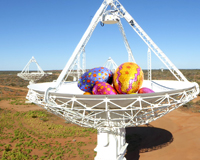Egg-actly what you weren't expecting
24 March 2016
The Evolutionary Map of the Universe (EMU) ASKAP Survey Science Project aims to understand how galaxies form and evolve, but faces a significant data challenge in their plan to detect some 70 million sources (compared to the 2.5 million currently known). The project will use ASKAP to create a census of radio sources in the sky, most of which are millions of light years away and contain massive black holes, and may also stumble across some completely new types of objects along the way.
According to EMU’s Principal Investigator Ray Norris, whenever the Universe is observed in a new way, significant discoveries arise when an open-minded researcher recognises something odd in their data.
“Given that EMU will significantly expand the volume of observational phase space, we can be reasonably confident that we will stumble across unexpected new phenomena,” says Ray, “However, the complexity of the instrument and the large data volumes mean a class of objects may lie undiscovered for decades because it didn't happen to fall within the selection criteria of the research at the time.”
In order to learn how to mine ASKAP data for these unexpected discoveries, EMU has kicked off a sub-project called the Widefield ouTlier Finder (or WTF for short), which involves the development of algorithms to search for phenomena beyond the limits of current astronomical knowledge.
“There are three outliers we will be looking for,” explains Ray, “Firstly, the artefacts, which are important for quality control, then statistical outliers, which are interesting, and then, most importantly, the entirely unexpected bits of science, the ones that make us stop and say – WTF?”.
Software for data reduction, calibration and viewing has recently been installed on Amazon Web Services* servers, which can be run from a desktop computer. The EMU team has manually inserted ‘EMU Eggs’ – objects that might pose a challenge to data mining algorithms – in to this data.
These eggs will be used to test how well the cloud-based computer program will recognise sources that systematically departs from the known categories of astronomical objects. That way, the team hope to be better prepared for unanticipated discoveries that would otherwise remain unhidden.
*EMU has received a grant to develop a cloud computing platform for machine learning as part of the AstroCompute in the Cloud collaboration, driven by Amazon Web Services (AWS) and the SKA Telescope. The collaboration is intended to accelerate the development of innovative tools and techniques for processing, storing and analysing the global astronomy community’s vast amounts of astronomic data in the cloud.
Back to Latest ASKAP News page.

